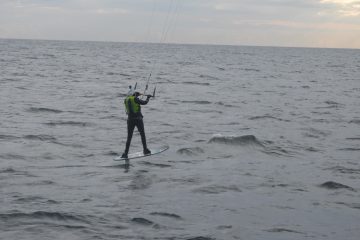Stew and Islay have two boards each, a twin-tip and a foil board. Most people when they learn to kite will learn on a twin-tip, but over the last few years foil-boards have really started taking off. This trend will likely continue growing with the news earlier this May of kite-racing being added to the 2024 Olympics.
On this trip, when we’re travelling, there are two main factors which determine our board choice:
Direction of Travel
Similar to sailing boats, we cannot travel directly into the wind. Therefore we will travel at an angle each side of the wind, tacking between the two to reach the desired upwind direction. Foils because they travel faster create apparent wind and can go at a tighter angle to the wind than a twin-tip. A twin-tip because of the additional friction in the water can only make approximately 80 degrees to the wind, hence creating a lot longer/slower progress upwind. (It is also more effort for the rider). Hence most upwind days on this trip we’ll usually be on our foil boards.
Downwind is similar, you cannot head in the same direction as the wind is blowing. Both Stew and Islay are relatively new to the foil boards, our angle is wider than most professionals, so actually we make better downwind track on our twin-tips.
Wind Strength
Once the foil board breaches the surface, it requires very little power from the kite to continue propelling you forward. Therefore if the wind is marginal, we will usually be using our foils. Conversely if the wind is on the upper end of the spectrum, you can handle more power on the twin-tip. This is because you can dig the rail/edge of the board into the water counteracting the pull and power in the kite.
On a foil you can become overpowered quite easily. If you are feeling overpowered, you can either head further into the wind, if you’re going in an upwind course, or head further away from the wind if heading downwind. This will help release the power in the kite and slow you down. If however you’re going on a beam reach, i.e. at 90 degrees to the wind, so neither up- or downwind then there is no way of releasing the power. This can make it a difficult direction on the foil boards if you’re not on the perfect size kite.
